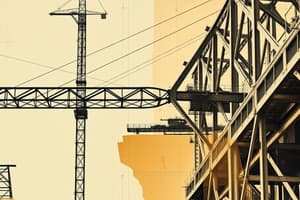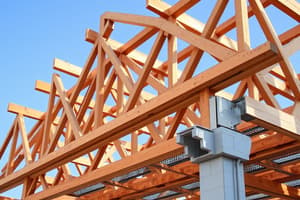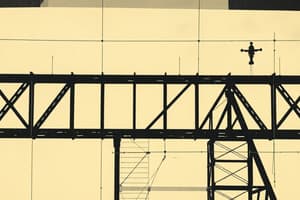Podcast
Questions and Answers
What is the total reaction force at support R?
What is the total reaction force at support R?
- 4000 lb
- 3500 lb
- 5000 lb
- 7000 lb (correct)
What forces are acting at joint A?
What forces are acting at joint A?
- AB and BD
- BC and CD
- AB and AC (correct)
- AB and CD
What is the force in member AC?
What is the force in member AC?
- 866.03 lb
- 6062.18 lb (correct)
- 7000 lb
- 3175.43 lb
Which member has a force equal to 7000 lb?
Which member has a force equal to 7000 lb?
How is the force in member CD calculated?
How is the force in member CD calculated?
What is the force in member DE equal to?
What is the force in member DE equal to?
At which joint are there only two unmarked members acting?
At which joint are there only two unmarked members acting?
What is the force in member BC when computed using the method of sections?
What is the force in member BC when computed using the method of sections?
Which member experiences a force of 80 kN?
Which member experiences a force of 80 kN?
What is the force value in member CE?
What is the force value in member CE?
What type of force does member DE experience?
What type of force does member DE experience?
What would be a similar problem to determine the force in members of a Howe truss structure?
What would be a similar problem to determine the force in members of a Howe truss structure?
When analyzing member BF of the truss by the method of sections, what is its force value?
When analyzing member BF of the truss by the method of sections, what is its force value?
Why is it important to state whether truss members are in tension or compression?
Why is it important to state whether truss members are in tension or compression?
What maximum force P can be applied to the truss without exceeding allowable limits?
What maximum force P can be applied to the truss without exceeding allowable limits?
What is the reaction force at point A in the horizontal direction?
What is the reaction force at point A in the horizontal direction?
What is the value of the force in member DE?
What is the value of the force in member DE?
What is the direction of the force in member AD?
What is the direction of the force in member AD?
For joint A, what is the equilibrium equation used to solve for member AE?
For joint A, what is the equilibrium equation used to solve for member AE?
What condition must be satisfied for equilibrium at joint B in the x-direction?
What condition must be satisfied for equilibrium at joint B in the x-direction?
What force does member BE carry?
What force does member BE carry?
What is the resultant force at joint C confirming the equilibrium?
What is the resultant force at joint C confirming the equilibrium?
How is the force in member AE determined from joint A's vertical equilibrium?
How is the force in member AE determined from joint A's vertical equilibrium?
What is the resulting force in member AB after solving for joint A?
What is the resulting force in member AB after solving for joint A?
What is the formula for calculating the total area of two shapes where $A_1 = 2 \text{ in}^2$ and $A_2 = 1.25 \text{ in}^2$?
What is the formula for calculating the total area of two shapes where $A_1 = 2 \text{ in}^2$ and $A_2 = 1.25 \text{ in}^2$?
How is the centroid $y$ calculated for a given area using its individual areas and centroids?
How is the centroid $y$ calculated for a given area using its individual areas and centroids?
If $A_1 = 150 \times 20 \text{ mm}^2$, what is the value of $A_1$?
If $A_1 = 150 \times 20 \text{ mm}^2$, what is the value of $A_1$?
What does the moment of inertia represent in structural engineering?
What does the moment of inertia represent in structural engineering?
Given $y_2 = 225 \text{ mm}$, for what purpose is this value calculated?
Given $y_2 = 225 \text{ mm}$, for what purpose is this value calculated?
In the equation $25000y = 3000 \times 460 + 27000 \times 225 - 5000 \times 125$, what does each term represent?
In the equation $25000y = 3000 \times 460 + 27000 \times 225 - 5000 \times 125$, what does each term represent?
What is the expression for the area $A$ when $A_1$, $A_2$, and $A_3$ are involved?
What is the expression for the area $A$ when $A_1$, $A_2$, and $A_3$ are involved?
What does the coordinate of the centroid (0.8269, 1.3269) indicate in the context?
What does the coordinate of the centroid (0.8269, 1.3269) indicate in the context?
What is the area of the shape defined by $A1$?
What is the area of the shape defined by $A1$?
What is the $y$ coordinate of the centroid for the area calculated from the formula $Ay = ay$?
What is the $y$ coordinate of the centroid for the area calculated from the formula $Ay = ay$?
Which expression represents the $x$ coordinate of the centroid for the circular segments?
Which expression represents the $x$ coordinate of the centroid for the circular segments?
How is the area of the triangular segment calculated?
How is the area of the triangular segment calculated?
What is the relationship between $x1$, $x2$, and areas $A1$ and $A2$ in calculating $x$?
What is the relationship between $x1$, $x2$, and areas $A1$ and $A2$ in calculating $x$?
What is the correct area of the circular segment represented by $A3$?
What is the correct area of the circular segment represented by $A3$?
How is the area of the shaded region defined?
How is the area of the shaded region defined?
Where is the centroid of the area represented by $y2 = ax$ located?
Where is the centroid of the area represented by $y2 = ax$ located?
In determining the $x$ coordinate of a centroid, which formula is applied?
In determining the $x$ coordinate of a centroid, which formula is applied?
What is the formula for finding the area of a parabola given in the form $y^2 = ax$?
What is the formula for finding the area of a parabola given in the form $y^2 = ax$?
What does the moment of inertia determine for a solid member?
What does the moment of inertia determine for a solid member?
What units is the area moment of inertia measured in?
What units is the area moment of inertia measured in?
What is the correct formula for the radius of gyration expressed in terms of moment of inertia and area?
What is the correct formula for the radius of gyration expressed in terms of moment of inertia and area?
Which of the following variables is NOT part of the transfer formula for moment of inertia?
Which of the following variables is NOT part of the transfer formula for moment of inertia?
In the context of the radius of gyration, which statement is true?
In the context of the radius of gyration, which statement is true?
How is the area moment of inertia denoted mathematically for the x-axis?
How is the area moment of inertia denoted mathematically for the x-axis?
Which variable represents the centroidal axis in the transfer formula for moment of inertia?
Which variable represents the centroidal axis in the transfer formula for moment of inertia?
If a solid member's area increases, what is the expected impact on its moment of inertia?
If a solid member's area increases, what is the expected impact on its moment of inertia?
What is the main relationship illustrated by the formula $I = A k^2$?
What is the main relationship illustrated by the formula $I = A k^2$?
Flashcards
Moment Equilibrium
Moment Equilibrium
The sum of the moments about a point is zero.
Force Equilibrium
Force Equilibrium
The sum of the forces acting on an object is zero.
Fixed Support
Fixed Support
A support that prevents both vertical and horizontal movement of a structure.
Reaction Force
Reaction Force
Signup and view all the flashcards
Joint Analysis
Joint Analysis
Signup and view all the flashcards
Tension Force
Tension Force
Signup and view all the flashcards
Compression Force
Compression Force
Signup and view all the flashcards
Truss
Truss
Signup and view all the flashcards
Fink Truss
Fink Truss
Signup and view all the flashcards
Equilibrium Check
Equilibrium Check
Signup and view all the flashcards
Member Force
Member Force
Signup and view all the flashcards
Method of Joints
Method of Joints
Signup and view all the flashcards
Joint
Joint
Signup and view all the flashcards
Pin-connected
Pin-connected
Signup and view all the flashcards
Equilibrium
Equilibrium
Signup and view all the flashcards
Symmetry
Symmetry
Signup and view all the flashcards
Center of Gravity
Center of Gravity
Signup and view all the flashcards
Centroid
Centroid
Signup and view all the flashcards
Method of Sections
Method of Sections
Signup and view all the flashcards
Howe Truss
Howe Truss
Signup and view all the flashcards
Moment of Inertia
Moment of Inertia
Signup and view all the flashcards
Tension Member
Tension Member
Signup and view all the flashcards
Compression Member
Compression Member
Signup and view all the flashcards
Centroid of a Shape
Centroid of a Shape
Signup and view all the flashcards
Parabola's Property
Parabola's Property
Signup and view all the flashcards
Parabola Centroid X
Parabola Centroid X
Signup and view all the flashcards
Parabola Centroid Y
Parabola Centroid Y
Signup and view all the flashcards
Triangle Centroid Location
Triangle Centroid Location
Signup and view all the flashcards
Triangle Centroid Distance
Triangle Centroid Distance
Signup and view all the flashcards
Combined Shape Centroid
Combined Shape Centroid
Signup and view all the flashcards
Moment about Y-axis
Moment about Y-axis
Signup and view all the flashcards
Moment about X-axis
Moment about X-axis
Signup and view all the flashcards
Centroid Coordinates
Centroid Coordinates
Signup and view all the flashcards
Area Moment of Inertia
Area Moment of Inertia
Signup and view all the flashcards
Radius of Gyration
Radius of Gyration
Signup and view all the flashcards
Transfer Formula for Moment Of Inertia
Transfer Formula for Moment Of Inertia
Signup and view all the flashcards
Centroidal Moment of Inertia
Centroidal Moment of Inertia
Signup and view all the flashcards
Moment of Inertia of Common Shapes
Moment of Inertia of Common Shapes
Signup and view all the flashcards
Moment of Inertia about the x-axis
Moment of Inertia about the x-axis
Signup and view all the flashcards
Moment of Inertia about the y-axis
Moment of Inertia about the y-axis
Signup and view all the flashcards
Study Notes
Analysis of Structures
- The analysis of a structure involves determining how loads are distributed.
- The discussion is limited to pin-connected structures.
- Three types of structures are considered: trusses, frames, and machines.
- Trusses are stationary structures consisting of only two-force members.
- Frames are stationary structures with at least one multi-force member (3 or more forces).
- Machines are structures designed to exert forces (such as a hand tool) and contain at least one multi-force member.
Trusses - Terminology and Assumptions
- Trusses are structures made of straight, slender bars joined to form triangles.
- Members and joints are key components.
- The entire truss is mounted on supports.
- Assumptions for trusses:
- Stationary structures
- Rigid (do not collapse)
- Primarily 2D, though 3D (space trusses) analysis methods are applicable.
- Composed of only 2-force members.
- Joints are pinned (reaction at the pin has no moment)
- All loads applied at joints.
- Each member experiences only axial forces along the member's axis.
- Forces are either tension (T) or compression (C).
- Zero-force members can be present, which affects analysis methods.
Zero-Force Members
- Zero-force members might experience zero force under specific loading conditions.
- Recognizing these simplifies truss analysis.
- Zero-force members tend to be slenderer than main members.
- They are used to provide stability (especially during construction) or support if loading conditions change (e.g., snow or wind).
- If only two members form a joint with no external load or support reaction, the members are zero-force members.
- If three members form a collinear joint with no external force or support reaction, the third member is a zero-force member.
Method of Joints
- A systematic technique for analyzing each joint in a truss to determine forces in members.
- This is often the preferred method if the forces in all members are needed to be determined.
- Each joint is assumed to be in equilibrium.
- Only the forces in joints are summed; no moments at a joint are considered.
- Two equations (ΣFx = 0 and ΣFy = 0) are used for analysis.
- Procedure:
- Analyze the entire truss for external reactions.
- Choose a joint with only two unknown member forces.
- Draw a free body diagram of the chosen joint.
- Show member forces in tension.
- Positive results mean the forces are correct; negative results imply the drawn direction was incorrect.
- Determine the members as either tension (T) or compression (C).
Method of Sections
- This method divides a truss into two parts using an imaginary cut.
- This may help to easily determine the internal forces at the cut members.
- The forces on the segments are tensile or compressive along the member's length.
- This helps to find the internal tensions and compressions at specific locations within a member.
- Procedure:
- Decide how to cut the truss.
- Consider the easier side of the cut for calculations, to minimize reactions.
- Calculate necessary support reactions.
- Draw a free-body diagram of the selected portion of the cut truss.
- Apply equilibrium equations to find unknown forces.
- If unknown forces have a positive result, the member is in tension; if negative, the member is in compression.
Centroids and Centers of Gravity
- Centroid: a point where the area/volume is concentrated.
- Center of gravity: a point where the weight of a body is concentrated.
- The axis of reference is used to calculate the centroid/center of gravity, especially for plane figures. The axis of reference is normally taken as the lowest point of the figure to find the y-coordinate, and the leftmost point of a figure to find the x-coordinate.
- Centroids of composite bodies are calculated using integration methods. Calculating centroids of areas, lines, involves summation.
Moments of Inertia
- Moment of inertia (second moment of area): is the product of area and the square of its moment arm about a reference axis.
- It's crucial for determining a structural member's bending resistance.
- Larger moments of inertia indicate higher bending resistance, and conversely, smaller moments of inertia means a piece is likely more flexible.
- The radius of gyration (k) is an alternative way to express the distribution of area away from an axis. This combines the effects of moments of inertia and cross-sectional area.
- Transfer formula is used to locate moments of inertia.
Other Examples/Problems
- Numerous examples demonstrate the application of both methods (trusses, frames, or machines), along with different problem types that use these concepts.
Studying That Suits You
Use AI to generate personalized quizzes and flashcards to suit your learning preferences.





